Wetlands
What
A wetland is a naturally occurring area of land that is saturated with water. Wetlands may be natural or artificial and the water within a wetland may be static or flowing, fresh, brackish, or saline. Wetlands are a treatment system, removing contaminants through filtration, adsorption, plant-uptake, and chemical processes, such as denitrification.
A natural wetland is one which has ecosystems that are either permanently or seasonally saturated with water which creates habitats for aquatic plants and conditions that promote the development of hydric (wetland) soils, such as peat.
An artificial wetland is an engineered and constructed wetland which, as in a natural wetland, also acts as a biofilter. It has the capacity to remove a range of pollutants such as organic matter, nutrients, harmful microbes, pesticides, and heavy metals from the water.

Image Source: Carstensen et al., 2020
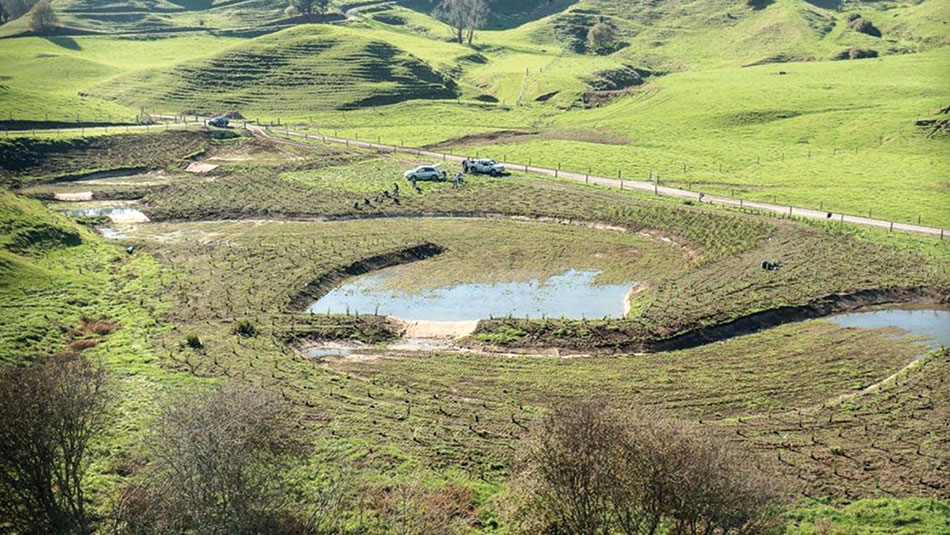
Image Source: DairyNZ
Why
Wetlands help prevent flooding and improve water quality, as well as providing the necessary habitat for a number of unique species of plants and animals. Conserving and restoring wetlands will provide many benefits to the wider environment. Since settlement in NZ began around 1250 AD, approximately 90% of natural wetlands have been lost.
Water storage: Wetlands act as a giant sponge, helping to soak up water and improve water quality. Wetlands help to regulate and store water as they fill with water when it rains and slowly release it through droughts. Plants in wetlands slow the flow of water off the land so that, in times of flood, more can be absorbed into the soil and taken up by the plant life. In summer, stored water is slowly released from wetlands, maintaining water flows.
Filtration and nutrient removal: Growing plants remove nutrients and play a cleansing role that protects the downstream environment. Bacteria in wetlands’ soils contribute to cleaner water by absorbing and breaking down about 90% of the nitrogen contained in farm run-off (such as in fertilisers, chemicals and animal wastes). This cleaner water prevents nuisance algal blooms and is better for livestock and wildlife. Plants also trap waterborne sediment, preventing silt entering streams and harbours.
A 2017 review by the National Institute of Water & Atmospheric Research (NIWA) of NZ natural seepage wetland studies found that NO₃ was 75-98% lower in wetlands out-flow waters compared to it’s in-flow waters, highlighting how effective wetlands are at denitrifying nitrate. This was true regardless of the methods used and whether concentrations or loads were compared.
Nitrogen removal from constructed wetlands in New Zealand has been found to range from 65% to 92%, and N removal increases linearly with plant biomass.
Biodiversity: Wetlands are among the most productive places on Earth, providing an enormous food source for fish, birds and other animals. They absorb large amounts of water and nutrients from outside sources and contain micro-organisms (fungi and bacteria) which efficiently decompose and recycle nutrients.
A cultural and recreational treasure: Wetlands are of great cultural and spiritual significance to Maori. They provide Maori with food in the form of wildfowl, tuna (eels) and other freshwater fish. Wetlands are also areas to grow taro and harvest harakeke (flax) and other materials for clothing, mats, medicines, dyes, food, building and crafts. As wetlands have diminished, so has this cultural tradition, along with the ability of Maori to pass it on to the next generation.
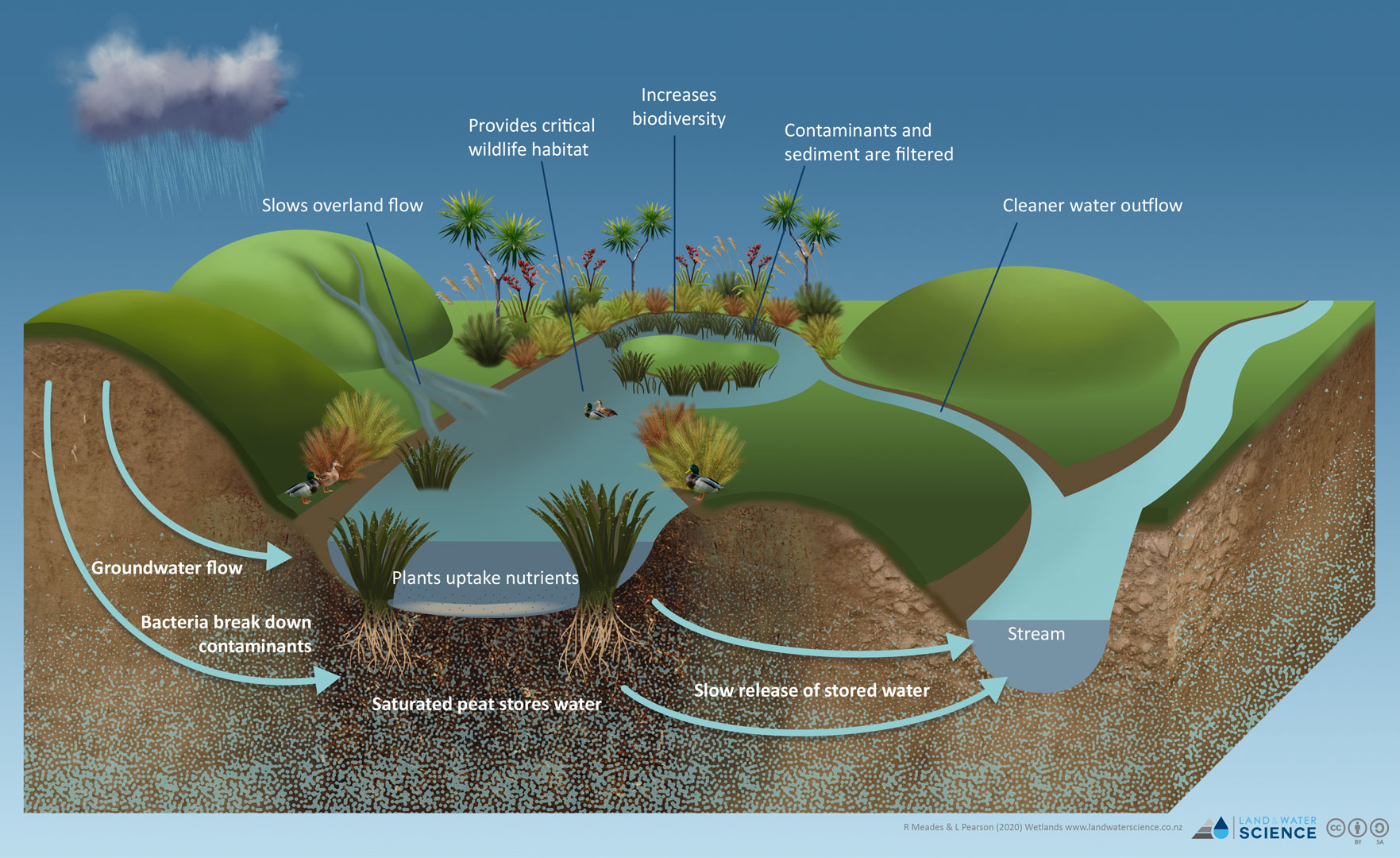
Types of Natural Wetlands
Common names for wetlands include swamps, bogs, fens, marshes, ponds, estuaries, mires, deltas, lagoons, lakes, and floodplains.
Swamps: Most wetlands on private land are swamps. They are fertile because they receive runoff from surrounding land which brings silt and organic matter. Swamp water levels fluctuate seasonally, and most swamps are in valley bottoms. Typical swamp plants include raupo, purei (Carex sedges) and harakeke (flax). The organic matter these plants produce encourages large populations of aquatic invertebrates and birds.
Bogs: Fed only by rainfall, bogs are naturally low in fertility and are acidic. They are home to a variety of specialist plant life, with the wettest dominated by sphagnum moss. Drier bogs support a variety of plants including sedges, rushes, umbrella ferns and manuka.
Seepages: These are places on slopes where water comes to the surface, often as small springs. They are common, but are seldom managed or appreciated.
Ephemeral wetlands: Seasonal or ephemeral wetlands are areas where water ponds in winter and dries up in summer. This gives rise to short, turf-like vegetation. The most common ephemeral wetlands are in coastal dunes where they are known as dune slacks.
Fens: These are the rarest type of wetland. They are largely infertile, like bogs, but because they also receive runoff from surrounding land, they have areas of fertility. They usually have higher biodiversity than other wetland types.
Floodplains: A floodplain is the area of land adjacent to a stream or river which stretches from the banks of its channel to the base of the enclosing landscape, and which experiences flooding during periods of high discharge. The soils usually consist of clays, silts, and sands deposited during floods.
Marshes: These are on flood plains associated with rivers, or next to lakes. At times they are flooded and at other times they are dry. Marshes may also have tall trees such as kahikatea, swamp maire, and pukatea which have adapted to living with their roots in waterlogged soil.
Shallow water - lakes, ponds, dune lakes and rivers: Open water is not strictly a wetland type, but it is often associated with shallow water margins surrounded by wetland vegetation. These areas are important water bird and native fish habitat. There are many examples of dune lakes in Northland.
Salt marshes/coastal wetlands: Estuaries (including salt marshes and mangroves) are the most productive of all wetlands and are especially rich in animal life. Many coastal fisheries depend on estuaries as fish spawning grounds.
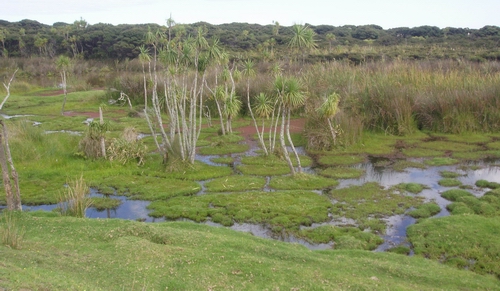
Image Source: Northland Regional Council
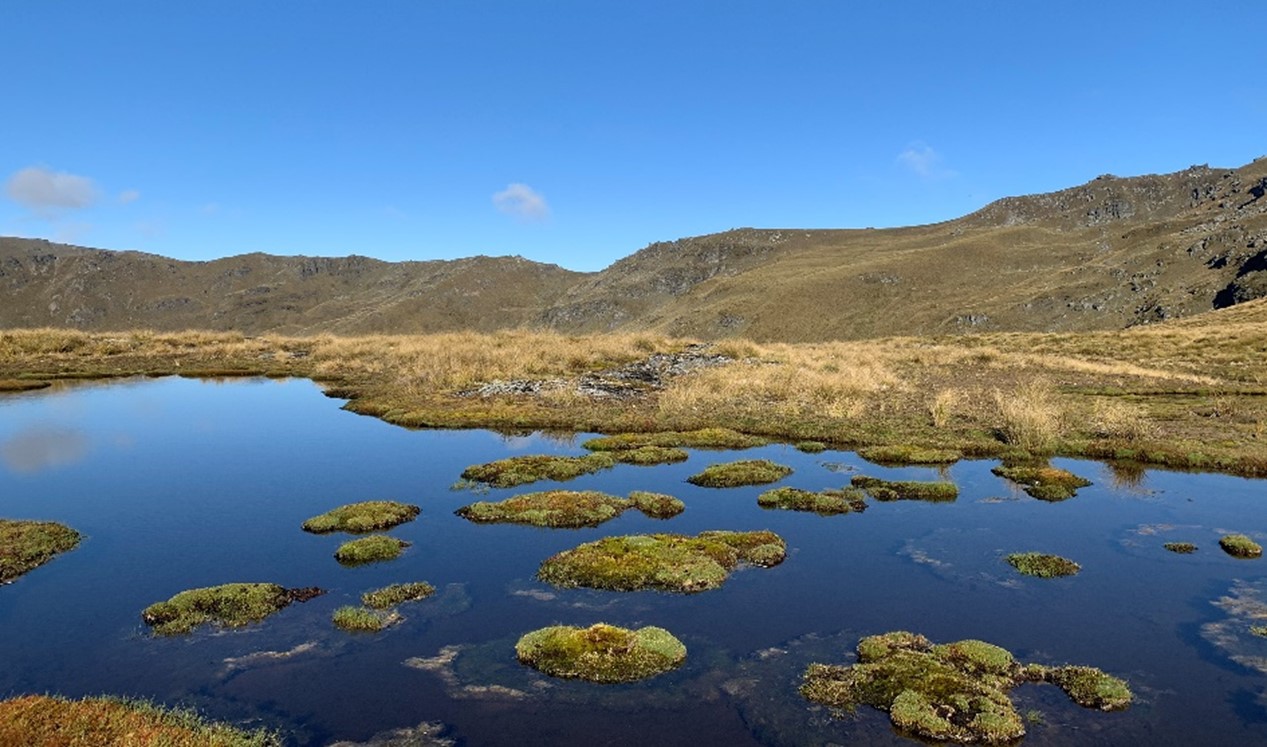
Image Source: Laura McDonald.
Examples
Living Water - Northland
In 2015 Living Water, Northland Regional Council, and Northland Fish and Game held a one-day workshop on how to construct a low-cost wetland. The workshop covered the benefits of wetlands, practical advice on selecting the best type of wetland, and information on construction regulations followed by an on-farm demonstration of construction in action.
Protecting and enhancing existing wetlands should be the first priority. However, if you have an area that’s wet or boggy, it’s likely a wetland existed there before drainage so could be a good place to create a wetland. Be sure to consult an expert as wetlands that are too small or in the wrong place can generate contaminants instead of attenuating them. Check with your local council about any regulations or funding that may be available.
Living Water have some advice from what they learnt from this project:
The planning stage is important and always check with your local council before starting any work.
Creating a wetland for a habitat is very different from constructing a wetland for water quality. Know your reason for construction and do the relevant research before you start.
Different regions will require different approaches to construction based on soil type, water flow, climate etc as well as different plant species.
Engaging with a professional in the early stages could save a lot of time and money.
Watch a video of a step by step guide to constructing a wetland.
Whakamana te Waituna - Southland
Whakamana te Waituna constructed a wetland on a dairy farm in the catchment. Funding support for this project was received from Ministry for the Environment, DairyNZ, and Living Water.
At the start of this project, NIWA was commissioned to identify the [most appropriate locations and types of constructed wetlands] (tanner-2013) that could be implemented in the Waituna catchment to intercept nutrients and sediments en route to streams and Waituna Lagoon.
Construction on the wetland pond was completed in March 2014, this flows into two phosphorous filtration beds which were constructed in December 2014. The phosphorus beds contain locally available material, one of lime rock and the other oyster shell to see if there is a difference in the nutrient uptake.
The wetland pond has been planted out with the native plant Eleocharis sphacelata or tall spike sedge to stimulate nitrate-removing bacteria. There were initially some issues with getting the Eleocharis established in the wetland pond due to Pukeko pulling them out, this was resolved with the use of cages to protect the plants while they were establishing. Another issue that arose was the slow growing nature of Eleocharis, and the lack of plant supply locally. A local nursery trialled different ways of growing stock, some were sourced from elsewhere in the country and others were also transplanted directly from a local landowner’s pond. As Eleocharis grows over time it spreads out to form a mat, so eventually the pond will be completely covered in it.
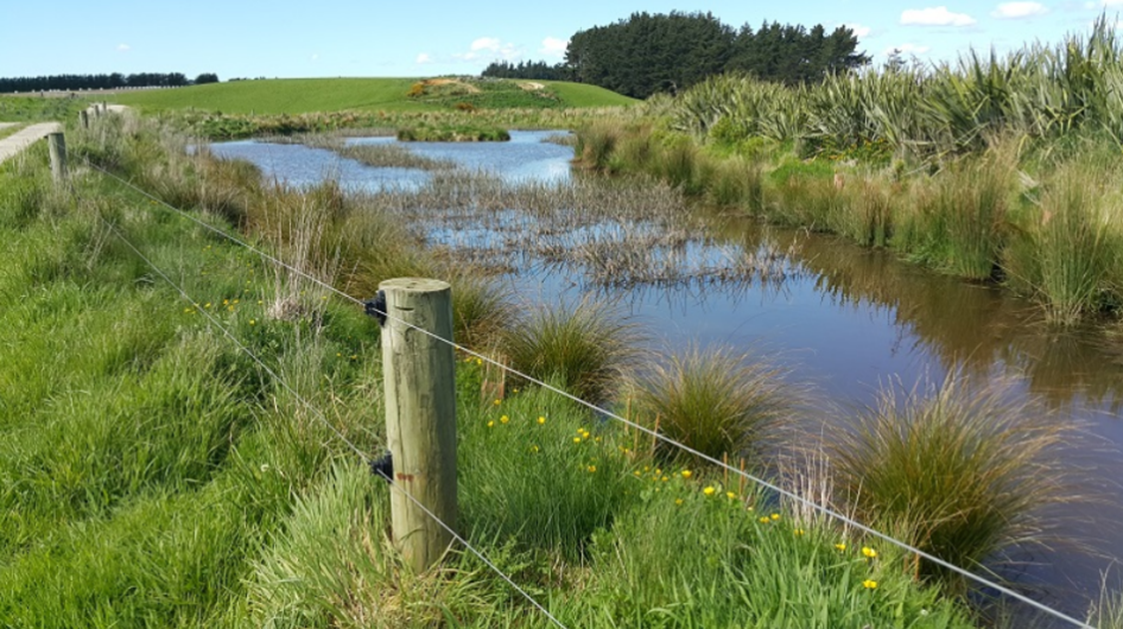
Image Source: Whakamana te Waituna - Katrina Robertson.
References
Carstensen, M. V., Hashemi, F., Hoffmann, C. C., Zak, D., Audet, J., & Kronvang, B. (2020). Efficiency of mitigation measures targeting nutrient losses from agricultural drainage systems: A review. Ambio, 49, 1820-1837.
Clarkson, B. R., Ausseil, A. G. E., & Gerbeaux, P. (2013). Wetland ecosystem services. Ecosystem services in New Zealand: conditions and trends. Manaaki Whenua Press, Lincoln, 192-202.
McDowell, R. W., Monaghan, R. M., Dougherty, W., Gourley, C. J. P., Vibart, R., & Shepherd, M. (2017). Balancing water-quality threats from nutrients and production in Australian and New Zealand dairy farms under low profit margins. Animal Production Science, 57(7), 1419-1430.
McDowell, R.W., Monaghan, R.M., Smith, C., Manderson, A., Basher, L., Burger, D.F., Laurenson, S., Pletnyakov, P., Spiekermann, R. and Depree, C. (2020). Quantifying contaminant losses to water from pastoral land uses in New Zealand III. What could be achieved by 2035? New Zealand Journal of Agricultural Research, 1-21.
McGlone, M. S. (2009). Postglacial history of New Zealand wetlands and implications for their conservation. New Zealand Journal of Ecology, 1-23.
Rutherford, J. C. (2017). Review of Nitrogen Attenuation in New Zealand Seepage Wetlands. NIWA Client Report 2017241HN.
Tanner, C. C. (1996). Plants for constructed wetland treatment systems — A comparison of the growth and nutrient uptake of eight emergent species. Ecological Engineering 7(1): 59-83.
Tanner, C. C., Nguyen, M. L., & Sukias, J. P. S. (2005). Nutrient removal by a constructed wetland treating subsurface drainage from grazed dairy pasture. Agriculture, ecosystems & environment, 105(1-2), 145-162.
Tanner, C. C., Long Nguyen, M., & Sukias, J. P. S. (2003). Using constructed wetlands to treat subsurface drainage from intensively grazed dairy pastures in New Zealand. Water Science and Technology, 48(5), 207-213.
Wilcock, R. J., Müller, K., van Assema, G. B., Bellingham, M. A., & Ovenden, R. (2012). Attenuation of nitrogen, phosphorus and E. coli inputs from pasture runoff to surface waters by a farm wetland: the importance of wetland shape and residence time. Water, Air, & Soil Pollution, 223(2), 499-509.